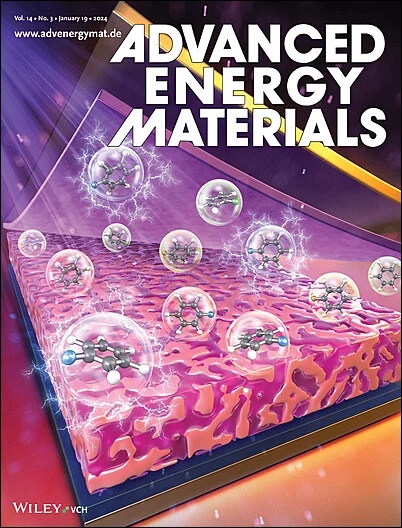Multi‐Site Lead Passivation via Spatial Configuration Modulation of Additives for Efficient Perovskite Solar Cells
IF 26
1区 材料科学
Q1 CHEMISTRY, PHYSICAL
引用次数: 0
Abstract
Perovskite solar cells (PSCs) hold great promise as the next‐generation low‐cost photovoltaic technology due to their solution processability; however, this very advantage introduces intrinsic defects and microstructural imperfections, often limiting their performance and stability. Here, 4,4′‐oxydibenzenesulfonyl chloride (OBSC), featuring a flexible backbone with two sulfonyl chloride (SO高效钙钛矿太阳能电池添加剂空间结构调制的多位点铅钝化
钙钛矿太阳能电池(PSCs)由于其溶液可加工性,作为下一代低成本光伏技术具有很大的前景;然而,这种优势引入了内在缺陷和微观结构缺陷,往往限制了它们的性能和稳定性。本文引入了4,4′‐氧基二苯磺酰氯(OBSC)作为双功能分子添加剂,其具有柔性骨架,具有两个磺酰氯(SO2Cl)基团,可以同时钝化钙钛矿薄膜中的缺陷和调节结晶。独特的空间结构实现了多位点配位,通过Pb−O相互作用与非配位铅(Pb2+)强结合,并通过氢键与甲脒(FA+)相互作用,有效抑制非辐射重组。同时,OBSC稳定了钙钛矿-溶剂中间相,延缓了结晶动力学,促进了高质量薄膜的形成,晶粒变大,陷阱密度降低。因此,优化后的psc显示出26.39%的冠军功率转换效率(PCE)(认证26.03%)。此外,该装置在连续一次太阳照射1100小时后仍能保持96%的初始PCE。这项工作证明了双功能添加剂在同时解决缺陷和结晶问题方面的有效性,为实现高性能、稳定的钙钛矿光伏电池提供了强有力的策略。
本文章由计算机程序翻译,如有差异,请以英文原文为准。
求助全文
约1分钟内获得全文
求助全文
来源期刊

Advanced Energy Materials
CHEMISTRY, PHYSICAL-ENERGY & FUELS
CiteScore
41.90
自引率
4.00%
发文量
889
审稿时长
1.4 months
期刊介绍:
Established in 2011, Advanced Energy Materials is an international, interdisciplinary, English-language journal that focuses on materials used in energy harvesting, conversion, and storage. It is regarded as a top-quality journal alongside Advanced Materials, Advanced Functional Materials, and Small.
With a 2022 Impact Factor of 27.8, Advanced Energy Materials is considered a prime source for the best energy-related research. The journal covers a wide range of topics in energy-related research, including organic and inorganic photovoltaics, batteries and supercapacitors, fuel cells, hydrogen generation and storage, thermoelectrics, water splitting and photocatalysis, solar fuels and thermosolar power, magnetocalorics, and piezoelectronics.
The readership of Advanced Energy Materials includes materials scientists, chemists, physicists, and engineers in both academia and industry. The journal is indexed in various databases and collections, such as Advanced Technologies & Aerospace Database, FIZ Karlsruhe, INSPEC (IET), Science Citation Index Expanded, Technology Collection, and Web of Science, among others.
 求助内容:
求助内容: 应助结果提醒方式:
应助结果提醒方式:


